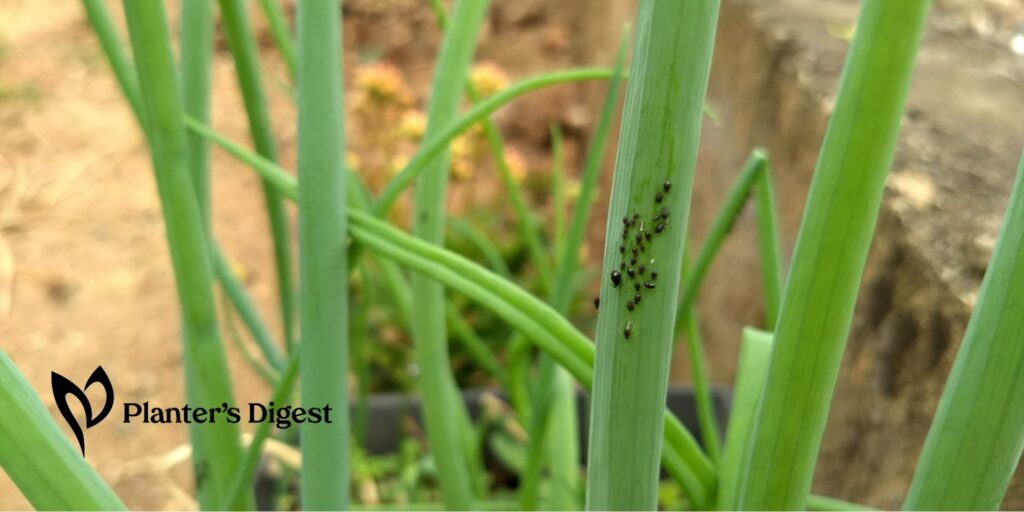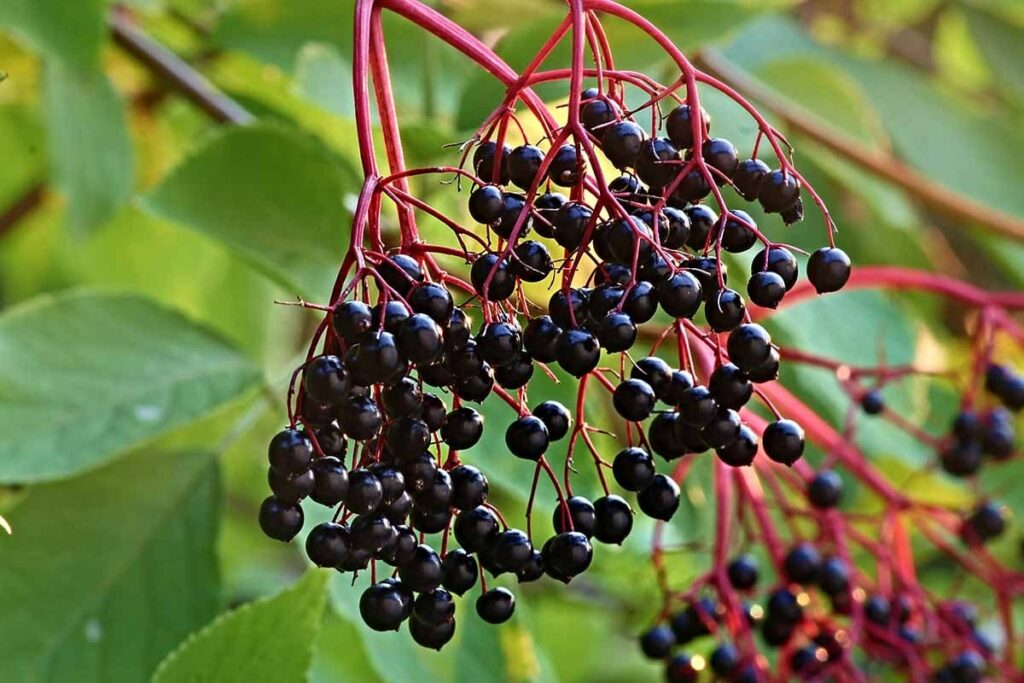When growing chives indoors or outdoors, it’s important to watch out for black bugs that can harm the plants. But even a low-maintenance herb like chives can play host to unwelcome guests, cue the mysterious and downright uninvited black bugs.
So, what’s the deal with those dark intruders on your beloved chives? These little critters could be any number of garden pests sporting a noir ensemble: black aphids, black thrips, black spider mites, or perhaps even black flea beetles.
Tiny troublemakers, they are, sucking the life out of your plants faster than you can shout “Pest control!” Their dastardly deeds leave behind a trail of withered foliage, threatening the very existence of your greenery.
A full-blown infestation spells doom for your chives unless you act swiftly to thwart their advances. Now, stay tuned as we uncover the secrets to identifying and booting these pests from your chive sanctuary.
Aphids

Aphids are little troublemakers who specialize in cozying up under leaves and along stems, making themselves unwelcome guests in your garden. Coming in hues from green to black, they’re like that annoying friend who always overstays their welcome.
If you spot a swarm of tiny black bugs, chances are it’s an aphid invasion crashing your greenery gala!
Treatment Against Black Aphids on Chives
Insecticidal soap, neem oil, and horticultural oil work well to control aphids. They smother the bugs but don’t hurt the plant.
How to Treat Black Aphids on Chives
- Identify aphids (including other colors and even other pests on this list) on chive plants.
- Prune infested areas.
- Use a strong stream of water to dislodge aphids.
- Apply insecticidal soap, neem oil, or horticultural oil solutions as directed on the package.
- Introduce ladybugs or lacewings.
- Monitor and repeat the treatment as needed.
Prevention Tips Against Black Aphids on Chives
- Grow different types of plants in your garden to bring in helpful bugs that eat aphids. Some examples are marigolds, lavender, dill, nasturtiums, fennel, and basil.
- Check your plants often for aphid clues like curled leaves or sticky honeydew stuff.
- Cut off heavily infested plant bits to stop aphids from spreading to the healthy parts.
- Too much nitrogen in fertilizers can make aphids thrive, so go easy on the fertilizer.
Thrips

Thrips are small, slender plant-sucking bugs. They come in black, brown, or yellow hues and leave behind silver streaks on leaves as a souvenir of their feasting frenzy.
Treatment Against Black Thrips on Chives
Like pesky aphids, thrips can be tackled with insecticidal soap, neem oil, or horticultural oil. For more lasting results, systemic insecticides are the way to go.
And don’t forget the good ol’ method of plucking and trashing heavily infested bits to keep those thrips in check!
How to Treat Black Thrips on Chives
- Check for thrips (not just black) on chive leaves.
- Prune heavily infested leaves or stems.
- Wash plants with a strong water stream.
- Apply insecticidal soap, neem oil, or horticultural oil as instructed on the package label.
- Use sticky traps near plants.
- Introduce predatory mites or minute pirate bugs.
- Monitor and repeat treatments as needed.
Prevention Tips Against Black Thrips on Chives
- Keep plant surroundings weed-free to prevent thrips and other pests.
- Mulch around plants to deter thrips from reaching leaves from the soil.
- Dispose of plant debris where thrips may shelter during winter.
- Plant nectar-rich flowers to attract natural thrips predators like ladybugs and predatory mites.
Spider Mites

Spider mites aren’t your average insects but tiny arachnids related to spiders and ticks. They’re so small they could easily hide in plain sight, sporting shades of black or red.
These sneaky critters dine by piercing plants and slurping up their juices, leaving behind a trail of discolored, speckled leaves.
Treatment Against Black Spider Mites on Chives
Pesky spider mites are the Energizer bunnies of the garden — multiplying like crazy and shrugging off pesticides like it’s nobody’s business! To keep them in check, you’ll need the big guns: specialized miticides.
And here’s a little DIY trick: give your plants a good spritz to up the humidity and make life less cozy for these critters.
How to Treat Black Spider Mites on Chives
- Inspect chive plants for spider mites: look for webbing, moving dots, and leaf discoloration.
- Prune heavily infested leaves or stems to stop spread.
- Rinse plants thoroughly to remove mites and webs, especially on the undersides of leaves.
- Apply insecticidal soap or horticultural oil to affected areas.
- Increase humidity by misting or using a humidifier.
- Introduce natural predators like predatory mites, ladybugs, or lacewings.
- Monitor and repeat treatments until spider mites are gone.
Prevention Tips Against Black Spider Mites on Chives
- Misting plants or using a humidifier deters spider mites.
- Space plants appropriately to prevent spider mite infestations.
- Clean plant leaves regularly with a damp cloth or spray of water to eliminate a protective barrier for spider mites.
- Promptly dispose of heavily infested plant parts to prevent mite spread.
Flea Beetles

Flea beetles are tiny, shiny, and jumpy — just like their flea namesakes! They’re leaf-munching fiends that love snacking on plants like chives, leaving behind a trail of small, funky-shaped holes.
Treatment Against Black Flea Beetles on Chives
Flea beetles can be controlled with insecticidal soap, neem oil, or pyrethrin-based sprays. And if you want to get physical, slap on some row covers to keep those critters away from your precious plants!
How to Treat Black Flea Beetles on Chives
- Inspect chive plants for flea beetles — small, shiny, black, or bronze beetles jumping away and tiny holes in leaves.
- Remove heavily infested leaves or stems.
- Use floating row covers to block flea beetles.
- Apply neem oil or spinosad for organic control.
- Introduce parasitic nematodes or ground beetles.
- Monitor and continue treatment until flea beetles are managed.
Prevention Tips Against Black Flea Beetles on Chives
- Cover plants with row covers to keep out flea beetles.
- Plant trap crops like radishes or mustard greens.
- Use organic mulch to discourage flea beetles from laying eggs in the soil.
- Grow aromatic herbs like basil or catnip to repel flea beetles.
How to Keep Chives Healthy to Ward Off Pests
Image by Homesteading Family
So, now that we’ve got the lowdown on handling those pesky black pests invading your chives, let’s dish out some great tips for keeping your chives in tip-top shape, practically giving pests the cold shoulder!
Promote Good Plant Health
The first thing to do is keep those chive plants in tip-top shape. Healthy plants mean pest-fighting champs!
Give them what they need: sunlight, water, and well-draining soil. Easy on the fertilizer, especially the nitrogen stuff — too much and you’ll have aphids crashing the party.
Implement Companion Planting
It’s best to plant chives with buddies that bugs hate! Garlic, onions, or marigolds make great neighbors for chives, keeping pests at bay. Plus, throw in some basil, thyme, or mint for extra bug-repelling power!
Promote Mulching and Weeding
You can sprinkle organic mulch around your chive plants to stop weeds and keep moisture in check. Plus, it doubles as a no-entry sign for creepy crawlies like thrips and spider mites.
And don’t forget to weed out any unwanted guests lurking nearby!
Conduct Regular Inspections
Best to keep an eye on those chive champs! Signs to watch out for are chewed leaves, funky discoloration, or any sneaky insects making themselves at home.
And don’t forget to flip those leaves and scope out the stems — pests love to play hide and seek there!
Put Up Physical Barriers
For container-grown chives, slap on a mesh net to keep pesky flying bugs at bay.
In the garden, go for floating row covers. They shield your chives from pests without cramping their style under the sun.
Bring In or Encourage Natural Predators
It’s time to play Mother Nature’s matchmaker! You can build a diverse garden squad to keep those chive pests in check.
Ladybugs, lacewings, beetles, and wasps are your go-to winged warriors against these critters.
Also, steer clear of those nasty broad-spectrum insecticides that do more harm than good. Let’s keep our bug buddies safe and sound, shall we?





